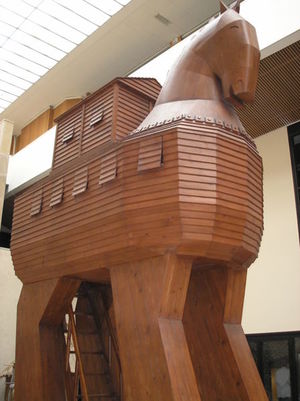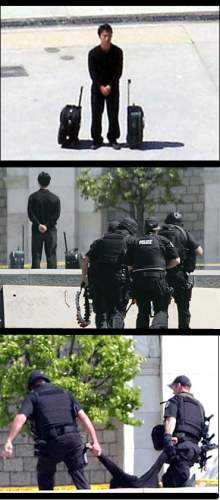Unclear weapons
The term Unclear Weapons denotes a whole family of killing devices with a not-too-obvious mode of action. These may include any kind of possibly-exploding devices, perhaps-toxic substances or generally scary objects you don't like the look of.
History of Unclear Weapons[edit | edit source]
Ancient usage[edit | edit source]
The first historically documented use of an Unclear Weapon was between 1300 BC and 1200 BC, during the Trojan War. Legend has it that the Greeks realized they would never be able to take Troy by force, so they decided to build a huge wooden horse, leave it at the gates of the city, and run away screaming as loud as they could. The effect was immediate. The Trojans were very unclear as to what the gargantuan timber equine was supposed to actually do to them, but damn they were scared. Panic struck, and the Trojans abandoned their city-fortress and ran away as far as they could. Later they were to establish themselves in what is now called France, and they named the capital after some sort of plaster.
Middle Ages[edit | edit source]
Since then, for unknown causes, the use of Unclear Weapons has drastically decreased. While it is known that during the Middle Ages many a pilgrim used scallops to defend themselves by instilling fear upon highwaymen ("I'm warning you, I've never seen it actually do anything, but i'd prefer not to...") military use of Unclear Weapons was essentially dormant until the discovery of America. This event also catalyzed, by sheer serendipity, the development of a new kind of unclear weapon: the bio-unclear weapon.
The Spanish Empire and Unclear Supremacy[edit | edit source]
1492, the year the first Spaniards reached the American Continent, had been declared a no-bathing year by the Pope. The Church was worried by the increasing level of pagan hygiene among the Europeans, who were beginning to take up to two or three baths per year, and had decided it had to stop. When the first Spaniards came into contact with the locals, the whiff must have been of epic proportions. Accustomed to the foul smell of poisonous fruit, the natives became convinced these white hairy balls of blubber must somehow be toxic. Thus, they decided not to eat them and the first Spanish expedition to the Americas returned safely to the mainland.
When the Europeans became aware of this, the unclarity of their odour would prove an important advantage in battle. Francisco Pizarro and Hernán Cortés, two slaves bred exclusively for their repulsive (and in the minds of the Indians, probably toxic) stench, were each able to single-handedly conquer the Inca and Aztec empires, by simply scaring the locals into getting poisoned if they stood to close to them.
Thus, Unclear Weapons would become a staple of Spanish military prowess. Through variations on this method they were able to conquer the whole American continent and most of Europe. The Dutch were duped into submission when the Spanish placed rubber chickens at the weak points of their dams and loudly remarked "They shouldn't explode if we watch them closely, surely!". Germany cowered into joining the Spanish Empire when someone strategically suggested that Spanish chorizo might interbreed with German sausages, with unpredictable consequences. Finally, Greece was conned into rendition when Phillip II remarked on how Spanish alchemists had actually gotten the wooden horse to actually work.
This strategy would finally fail when Phillip II was to attempt the conquest of his ex-girlfriend's kingdom by fleeting a large number of suspiciously large ships towards the English coast. However, he had made one terrible mistake, as Queen Elisabeth was wise to Phillips bluffs after suffering a severe boudoir disappointment. The cunningly named Invincible Armada was no match for a bunch of sceptic sailors armed with torches and was a miserable failure.
Sporadic usage of Unclear weapons during the XVIII and XIX centuries[edit | edit source]
The fall of the Spanish Empire brought with it a decline in the use of Unclear Weapons on a large scale. The Brits occasionally attempted to employ similar strategies during the American War of Independence. By dressing their soldiers in bright red jackets and tutus they hoped the rebels might feel unsure about the capabilities of Royalist troops, and refuse to fight such an unclear battle. However, George Washington was quick to respond by creating the elite corps of the Minutemen, colour-blind transvestites who were therefore immune to the unclarity of the enemy.
Finally, one last historic usage of unclear weapons was that of Napoleon Bonaparte. Bonaparte managed to conquer most of Europe by threatening to pull out whatever he was holding in his jacket and use it. This was sufficient to take over the whole continent. However, when he attempted to land on the British beach he made the mistake of swimming to land, thus exposing the contents of his jacket. It was merely a dead parrot. Word spread, and the Napoleonic troops were rapidly defeated.
Lately, Unclear Weapons have become the device of choice among terrorists.
Modern usage of Unclear Weapons[edit | edit source]
In recent years, unclear weapons have become available to almost anybody. This has provided easy access to these weapons to terrorists, who now have at their disposal weapons that could previously only be deployed by the most powerful European empires. Particularly since mid to late 2001, incidents of Unclear Weapon attacks have increased exponentially. The reason for this is unknown. However, police and security bureaus are taking the threat very seriously. Unclear weapons are considered by the UN as Weapons of Mass Destruction, and were the sole justification for the invasion of Iraq. The fact that no weapons have been found is greater proof to just how Unclear they were and their potential for destruction.
Notable incidents are:
- 12th of August 2002, JFK Airport, New York Woman attempts to take three bottles of breastmilk on to plane. Airport security is quick to identify them as unclear chemical weapons. Dead 7, Injured 0.
- 11th of April 2005, Washington D.C. Man stands outside Capitol with two unclear suitcases and is tackled by police. Dead 0, Injured 0.
- 22nd of July 2005, London Brazilian terrorist Jean Charles de Menezes boards Underground with suspiciously looking denim jacket, posibly an unclear weapon. Police are quick to shoot him down before he can do anything with it. Dead 1 (terrorist), Injured 0.
- 31st of January 2007, Boston Dozens of unclear terrorist devices appear distributed in Boston. Fortunately, none of them actually did anything thanks to the quick response of Boston police. The terrorist who placed them are now (as of April 2007) under trial. Dead 0, Injured 0.


